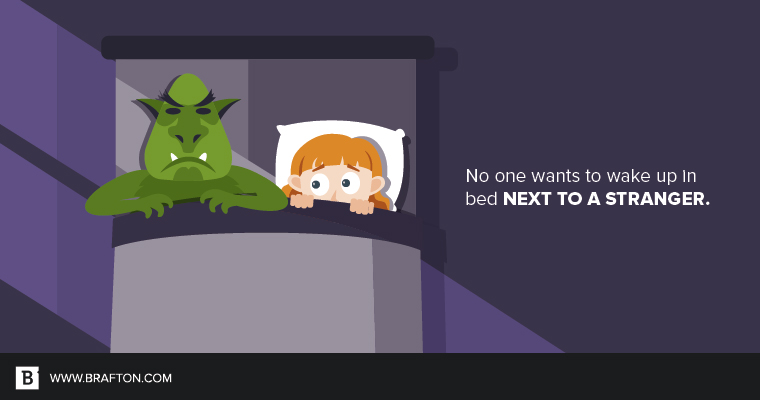Imagine waking up next to a stranger in bed. No, we’re not talking about your love life in college.
It would be a jarring experience, to say the least – especially if you dozed off lying next to someone else the night before.
Now you’re starting to understand why re-branding efforts can feel so wrong to consumers.
Brand development is about building a relationship with your customers. Branding is bonding, and the connection consumers feel to your brand isn’t something you can haphazardly tamper with.
In fact, the more success you’ve had with your brand, and the longer it’s been around, the more dangerous it is to rock the boat. Sure, re-branding can be invigorating, and sometimes even necessary, but it can wreak havoc on your bottom line if it’s not handled carefully.

The value of brand loyalty
Brand development is all about controlling consumer perception of your organization. Spoiler alert: You want people to trust you. Nobody hands over hard-earned cash to a brand they find unreliable or dishonest.
Unfortunately, that seems to be the default mode for many consumers. It’s reported that 54 percent of people don’t trust brands, primarily due to broken promises and unmet expectations. Meanwhile, 84 percent of millennials are wary of traditional advertising. Brands begin with their hands tied behind their backs.
But through proper brand development, which includes crafting a consistent brand voice and using content marketing to support brand management, businesses can create likeable personas and build trust with consumers. Likeability and trust were cited as two essential elements of loyalty by consumers. And, unsurprisingly, loyalty translates to that glorious “cha-ching” sound every business is hoping to hear.
Consider the following:
- It costs five times more to attract new customers than to keep existing ones.
- The probability of selling to an existing customer is between 60 and 70 percent, compared to between 5 and 20 percent for a new customer.
- Thirty-seven percent of brand loyal consumers make repeat purchases.
Re-branding rewind
So we know that brand loyalty boosts bottom lines. What about the impact of re-branding? If young children who are concerned about corporate profits are in the room, now would be a good time to ask them to leave.
Using a case study created by The Branding Journal, we can learn from the sad story of Abercrombie & Fitch, king of boy band-lyrics and preppy high school closets during the late 1990s and early 2000s.
While the brand was once able to shun consumers it didn’t consider its core demographic (i.e., uncool kids and people over the age of 18), it lost its market dominance as the culture changed. Re-branding seemed like a good idea.
Unfortunately, Abercrombie & Fitch based its re-branding on an overly broad strategy, resulting in a “vanilla-flavored brand” that didn’t appeal to anyone despite trying to widen its scope. No longer differentiated from other clothing retailers, former brand values forgotten and authenticity shredded, where does the brand stand today? It’s out in the wild, inspiring headlines such as the following: “Abercrombie & Fitch to Close Another 60 U.S. Stores as Sales Crater.” Ouch.
Even a simple brand refresh presents possible pitfalls. While re-branding means updating your company image from top to bottom, a refresh often encapsulates smaller changes like new logos, taglines and typography.
Simple enough, right? Wrong.
Tropicana learned this the hard way when it updated its packaging and created a furor among orange juice lovers.
“Don’t be afraid to revitalize your brand when necessary.”
Re-branding right
There are plenty of moving parts to account for when re-branding, but the emotional connection consumers have with your existing brand is arguably top dog.
It’s vital to do your homework and create a re-branding strategy accordingly. Get input from existing and former customers. Conduct competitive research. Talk to your sales department about what elements of your branding have succeeded and failed in the past.
Next, get your messaging squared away. Content marketing provides the ideal avenue for introducing your new brand, responding to customer concerns and demonstrating your commitment to value, relevance and transparency.
Finally, consider the role visual marketing will play in your re-branding.

From color schemes to illustration styles, changing up how your brand looks will make an impact on consumers, from subtle double takes to mass confusion.
Re-branding isn’t a process to take lightly. It requires resources and careful planning. That said, don’t be afraid to revitalize your brand when necessary. Sterile and stale won’t do you any favors, and now may be the time to reintroduce yourself to your target audience. Just remember: If you don’t do it right, you risk getting kicked out of bed.





